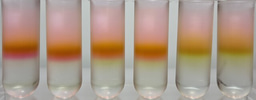Quantum sensing of magnetic fields with molecular spins

Explore the Research

Quantum sensing of magnetic fields with molecular spins - npj Quantum Information
npj Quantum Information - Quantum sensing of magnetic fields with molecular spins
Sensing local magnetic fields down to atomic or molecular level can be very challenging. In this context, quantum sensing, i.e. exploiting genuine quantum features to improve sensitivity with respect to classical sensor counterparts, can really make the difference. Quantum features typically monitored in quantum sensing protocols are: quantization of energy levels, quantum coherence or entanglement [Degen et al. Rev. Mod. Phys. 89, 035002 (2017)]. The change of at least one of such quantities is detected and can be related to the varition of the physical quantity to be measured. Due to their relatively long coherence time, spin are intrinsically-small and local probes which are suitable for probing magnetic fields. This requires the development of protocols for initializing their quantum coherence, in order to make them work as sensors, and, then, of protocols for their readout. This has been widely investigated in spin centers such as Nitrogen Vacancy (NV) centers, both in scanning probe microscopy as well as in optically detected magnetic resonance spectroscopy. Single or large collection of NV centers can be coherently addressed and used to probe their surrounding magnetic field and, eventually, other physical quantities such as temperature and acceleration. Individual spins can be addressed with scanning probe microscopy techniques and have the advantage given by the spatial resolution, but at the cost of faint signals,which typically results in long average times. Conversely, large collection of spins have the advantage given by the size of the sensor itself, which results in the parallel averaging of the individual responses of a large number of single spins, speeding up the time required for optical readout.
Molecular spins - i.e. magnetic molecules - have been proposed for quantum sensing protocols [Troiani et al. Journ. Magn. Mag Mat. 491, 165534 (2019)] but only marginally experimentally investigated. The mentioned proposal involve applications in quantum technologies such as the detection of magnetic fields, of temperature variations and of reduced number of photons originated by rare events, such as Dark Matter Axions. Magnetic molecules take the advantage of chemical synthesis, which allows for the realization of several identical copies of the same molecular unit with a relatively small cost. Chemical synthesis gives also the possibility to functionalize each molecule and to tailor its magnetic properties. For instance, it is possible to attach molecules of different species to obtain functional molecules responding to visible light, molecular dimers with identical or different magnetic ions or, eventually, molecular clusters. Molecular spins hold potential for quantum technologies, especially when embedded into planar microwave resonators and hybrid quantum circuits. This hybrid approach combines the scalability of hybrid quantum circuits with synthetic strategies designed to obtain an interplay between memory times and spin concentration. Memory times from few up to ten microseconds can be achieved while maintaining, at the same time, relatively high spin concentrations. We have shown that it is possible to adress molecular spins coupled to planar microwave resonators by meas of microwave pulse sequences, and to cohently manipulate them with Dynamical Decoupling and Storage Retrieval protocols [Bonizzoni et al. Appl. Magn. Res. 54, 143 (2023); Bonizzoni et al. npj Quantum Inf. 6, 68 (2020)]. Additionally, we have shown that machine learning methods can be used to assist the readout of the amplitude or of the phase of molecular spin qubits [Bonizzoni et al. Phys. Rev. Appl. 18, 064074 (2022)]. This initial work allows for a possible future extension of similar readout methods also within artificial intelligence algorithms, especially in the view of measuring small signals which can be highly affected by noise. Due to this large potential, it is quite natural to wonder whether or not molecular spins can work also for quantum sensing. Due to their intrisic nature of spins, the first straighforward application concerns the sensing of magnetic fields.
In our work, we experimentally implement quantum sensing protocols for the detection of AC magnetic fields on molecular spins embedded into hybrid quantum circuits. A planar microwave resonator is used to manipulate spins and to obtain a coherent spin echo, which acts as a sensor. We test our sensor by sending an AC magnetic field on the sample through a dedicated line ended by a radiofrequency coil. The Hahn echo sequence protocol carried out with and without the additional AC field reveals that it is possible to relate the change of the phase of the spin echo to the amplitude, the phase or the symmetry of the AC magnetic field profile applied. This shows that AC magnetometry can be successfully implemented on molecular spins in a relatively easy way and at microwave frequency, without the need for optical detection. We then exted our results to the case in which the spin echo is obtained from Dynamical Decoupling protocols. The sensitivity is found to increase up to S ≈ 10−10 − 10−9 T Hz−1/2 with a low (4-5) number of applied pulses. Againg, the readout of the sensor is performed at microwave frequency, without optical detection. This reduces the time required for signal acquisition and for running experiments. The minimum detectable field is equal or below the value which would be given by a single spin with a magnetic moment equal to one Bohr's magneton at a distance of 5-10 nanometers from a single molecular sensor, showing that probing local fields down to single spin level is feasible. These results paves the way for developing strategies to implement quantum sensors with molecular spins. In particular, chemical synthesis would allow to attach a molecular sensors to a specific surface or a specific magnetic center and to locally probe it. The response of a large number of molecules working as local sensors would improve the sensitivity. Chemical synthesis would also allow to place a molecular sensor and to perform local spectroscopy on the environmental noise, especially when the magnetic center is silent in electron spin resonance spectroscopy. Of course, these results are of high interest in the community of physicists and chemists working on molecular magnetism and can stimulate further discussion and results on the design of both sensing protocols as well as of new synthetic strategies. Our results are also of interest in the desing of hybrid quantum systems based on molecules attached to different spin centers or different quantum systems.
Follow the Topic
-
npj Quantum Information

The scope of this journal spans across all relevant disciplines, fields, approaches and levels and so considers outstanding work ranging from fundamental research to applications and technologies.
Your space to connect: The Polarised light Hub
A new Communities’ space to connect, collaborate, and explore research on Light-Matter Interaction, Optics and Photonics, Quantum Imaging and Sensing, Microscopy, and Spectroscopy!
Continue reading announcementRelated Collections
With Collections, you can get published faster and increase your visibility.
Algorithms, Protocols and Architectures for Early Fault Tolerance
Publishing Model: Open Access
Deadline: Jun 25, 2026
Quantum-Enabled Bioimaging
Publishing Model: Open Access
Deadline: May 04, 2026



Please sign in or register for FREE
If you are a registered user on Research Communities by Springer Nature, please sign in